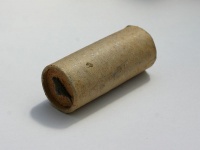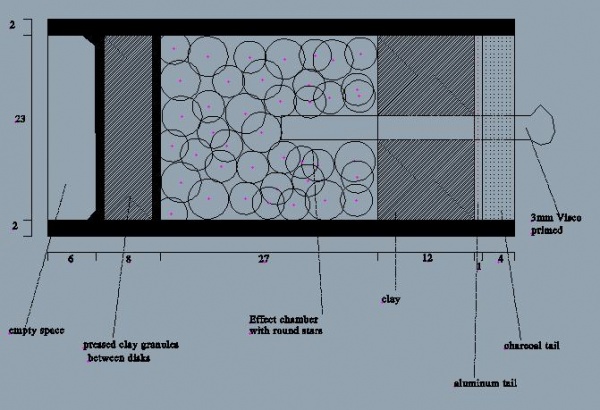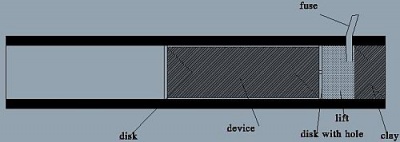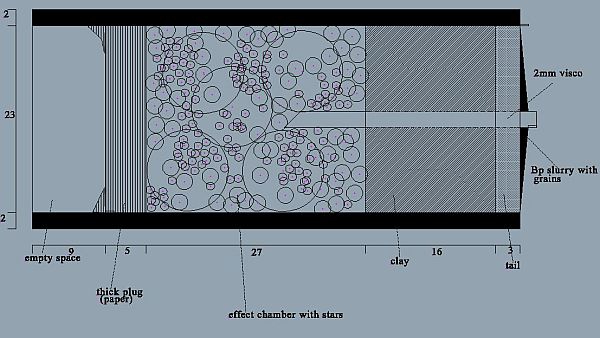Bombettes and Comet Bombs[]
Note that this page is currently the object of modification according to the author´s recent findings. The powdered material contained in bombettes is not primer or effect comp as repeatedly stated below, but flash powder in one or the other variety. Consequently the construction of these units becomes tendentiously inadvisable for inexperienced pyrotechnicians! The page will be updated soon to offer the correct information at the proper places.
Commercial bombette cakes
Bombette unit (Example F)This page deals with bombettes (small caliber cylindrical shells) and closely related items called comet bombs. Bombettes find widespread use in contemporary pyrotechnics and in fact the vast majority of standing fire consumer fireworks devices employ these more or less easy to manufacture items.
The cylindrical devices are shot from small cardboard mortars (frequently coming as "cakes") or from candles up to the one inch bore or even larger. Superb effects can be obtained with even the most mousy devices and the author really got stunned when he shot some one inch cakes whose effect scored off large rockets and even some small shells. This may come from the fact that bombettes generally explode closer to the observer than rockets or large shells; thus the effect looks as good or even better although it operates at about 50m maximum heights.
The industry actually does a lot of research to produce the maximum effect with the minimum load (cost) and these devices seem like a highly promising offspring: in fact one couldn't doubt bombettes coming in consumer fireworks show characteristics close to the optimum ratio between load and effect. This will become obvious in what follows.
This page features the result of the dismantling of various commercial items. It tries to make plain the (simple and very similar) construction principles by means of examples showing different versions of the devices. These examples can be used both as is for manufacture or to design ones own devices. It is plain that the manufacturer has to conform to some guidelines e.g. the right ratio of length/bore of the device to mortar length, to use the right strength of paper etc. and thus creative manufacture may be a process of trial and error, but a working device is fun.
It must be noted that author did not analyze the compositions in detail. Maybe these will have to be adjusted to provide enough force etc.
All sizes in: mm
_________
Example A: Cal. 17mm Bombette (originally coming in cakes of 25 Shots)
Device :
O.D.: 16
I.D.: 14
Length: 48
Wall: 1 mm kraft
Weight: 11,7 g
Lift: 1,4 g commercial 3FA
Effect:
net. weight: 2,2 g (of which about 18 4-5mm round stars and 0,5g of additional effect or primer comp in powder form)
Description:
This is a simple form of bombette. The convoluted tube is prepared and 5mm of aluminium composition (e.g. silver wave) is pressed into the tube with a hand or hydraulic press followed by 8mm of clay. To integrate the visco it is either possible to use special tooling when pressing (e.g. make use of a spine and perforated plunger) or to drill the clay etc. after pressing. Never drill the device after the effect has been poured in! Using the latter method, the fuse is integrated after drilling(see if it fits narrowly).
Then the load is poured in. It is a rule of thumb to add some powdered composition to the stars to ensure ignition and produce force. Bombettes generally need no break charge as the burning stars and the powder are strong enough to break the shell. Next we apply a cardboard disk (somewhat larger than the ID) and push it down to seal the star chamber. Afterwards we press in damp (kneadable) clay with the fingers until we reach the top of the device. The cardboard disk prevents the moisture from soaking into the effects. Applying damp clay is a primitive but comfortable way to seal the tube. Fuse and tail are primed with gunpowder slurry and the finished device is laid aside for drying.
Loading :
The finished device is loaded into a thick kraftpaper tube. The dimensions are critical inasmuch the ratio between lift, bore and length of the mortar largely determines the altitude the device reaches. In this special case we prepare a convoluted tube of the following dimensions: 120mm in length, 17mm I.D. and a wall thickness of 3mm. We seal one end with 1cm of clay and drill a hole barely across (for the fuse).
Next the lift charged is dumped in followed by a disk with a small center hole (the fire will reach the device through this hole). Next we drop in our dry bombette (make sure it reached the bottom) and apply one last cardboard disk (about 20mm in diameter, but this is not critical) which holds the device in place. See the picture for demonstration.
The loading process always is the same with all types of bombettes; lift and tube dimensions have to be adjusted of course.
Example B: Cal. 30mm Bombette (originally coming in cakes of 10 Shots)
Device :
O.D.: 27
I.D.: 23
Length: 60
Wall: 2 mm kraft
Weight: 34,5 g
Lift: 2,7 g commercial 3FA
Effect:
net. weight: 13,7 g (of which 5 10mm round stars, the remaining space filled with 1-2mm spherical microstars and about 1g of additional comp powder)
Description:
This is a larger version and these units give superb effects when manufactured properly (the load is still very small but effective). The manufacture is very similar to example A and will be described in brief. The main difference is that we will make use of a thick paper plug (no clay) to finish the upper tube side. The tube is prepared and 3mm of a bright tail effect (of choice) is pressed in followed by 16mm of clay. The visco fuse is integrated either by drilling or via preperforation (see A).
Then the effect is dumped in. A paper liner (27mm high) can be used to know when to stop filling. Make sure there are some large stars included. You can replace the numerous spherical microstars with broken star fragments, very small cut stars etc. to recycle them, just make sure not to put in chlorate and sulfur comps (and other no-goes) together. Remember this small fillings cannot be omitted because they act as both small effects and break charge. Thus, it is not enough to fill the case with some large stars only. Lastly we put in about 1g of additional star comp in powder form (ignition).
Once the effect chamber is filled up, we close the chamber by gluing in a very thick cardboard plug (slightly larger than the I.D.) using elmers glue. Note: A common end plug will not do and does not withstand the internal pressure. Thus these plugs will have to be manufactured beforehand e.g. by gluing several cardboard disks together etc. to get a 5mm thick plug. Elmers glue is applied to the whole edge of the plug before it is pushed down into the tube and allowed to dry. Make sure the plug fits closely and strongly. The remaining space on the upside of the bombette is left free.
Once the units are dry we prime our tail and fuse with gunpowder slurry. After applying the slurry the device is dipped into some grain powder to improve ignition characteristics.
Loading :
The process is the same as in example A but we have to alter the tube dimensions. In this special case we prepare a convoluted tube of the following dimensions: 180mm in length, 30mm I.D. and a wall thickness of 4mm. We seal one end with 4cm of clay and drill a hole barely across (for the fuse). We put in fuse and lift followed by a perforated disk, then drop our bombette and push down a final disk.
Example C: Cal. 21mm Comet Bomb
Device :
O.D.: 20
I.D.: 18
Length: 52
Wall: 1 mm kraft
Weight: depending on load
Lift: needs adjustment
Effect:
Stars of various sizes or other effects
Description:
This shows a design given by Lancaster. In fact it is no bombette but a comet bomb and the design shows some principal deviations from the further e.g. there is no clay plugging at the base and no fuse necessary. The name "comet bomb" comes from the fact that the rising device looks like a comet star but moreover there is also a star burst at the apex the observers often do not expect. The possible effects again are very pleasing and the construction is very easy.
The tube is prepared and a suitable composition is pressed in to give us a large star at the bottom of the device. The item needs to be manufactured with care or otherwise there is a liability to get a blow through. Thus, the star "plug" must be sufficiently thick to resist the shock of the lifting charge and does not break apart. Furthermore the burning time and other properties of the composition used have to be adjusted. Otherwise the star e.g. burns out too early during flight. It is plain to see that one has to watch out for hazardous chemical combinations between the comet star and the effect load. Thus, we must avoid the use of e.g. a chlorate based comet star and ammonium perchlorate based filling.
Once the star is consolidated, the tube is filled with stars, whistles etc. until close to the top. Lastly the top end is plugged with a (3mm) thick end plug or strong disk we glue in place. If necessary, primer comp is applied to the comet star.
Loading :
The mortar tube will have to be adjusted to conform to the size of the units. In this special case the internal diameter would be about 21mm with at least 2mm kraft walls. The length also depends, but a ratio length of unit - bore similar to example A or B should work as a point of reference.
Examples D-F: Various Bombettes
These are other examples for bombettes. Manufacture and loading are quite similar to A-C. Therefore I will just give technical data.
Device :
O.D.: 17
I.D.: 15
Length: 57
Wall: 1 mm kraft
Weight: 14,2 g
Lift: 1,7 g commercial 3FA
Effect:
net. weight: 5,4 g (2mm microstars, 0,9g additional primer comp)
Description:
This was loaded with dragons eggs. Mortar dimensions are: I.D.: 19mm, 2,5mm Wall, Length: 110mm, 14mm clay
Device :
O.D.: 27
I.D.: 23
Length: 58
Wall: 2 mm kraft
Weight: 31,2 g
Lift: 1,9 g commercial 3FA
Effect:
net. weight: 11,3 g (10,7g of 4-5mm spherical stars and 0,6g primer powder)
Description:
This gave a blue starburst. Mortar dimensions are: I.D.: 30mm, 3mm Wall, Length: 172mm
Device :
O.D.: 26
I.D.: 22
Length: 63
Wall: 2 mm kraft
Weight: 33,3 g
Lift: 2,2 g commercial 3FA
Effect:
net. weight: 7,4 g (nine 8mm pumped stars and 1,1g of star primer comp)
Description:
Mortar dimensions are: I.D.: 29mm, 3mm Wall, Length: 172mm
Video:[]
A representative effect of a commercial bombette cake: http://www.youtube.com/watch?v=inYwpnYH-_g

Display fireworks cake - Willow to Red Green 49S I







